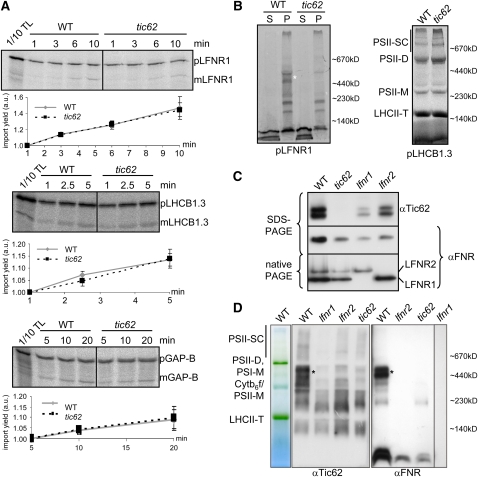Figure 4.
The Loss of Tic62 Does Not Affect FNR Import but Inhibits the Formation of FNR HMW Complexes.
(A) Import of pLFNR1 is not affected in tic62 chloroplasts. Import into isolated wild-type and tic62 Arabidopsis chloroplasts was started by the addition of translation product (pLFNR1 as well as pLHCB1.3 and pGAP-B as controls) and performed for the indicated time. Import products, including 10% of translation product (TL), were separated by SDS-PAGE, radiolabeled proteins analyzed by a phosphor imager, and the signals of the processed mature forms quantified (±sd; n = 3). p, precursor form; m, mature form; a.u., arbitrary units.
(B) LFNR1 integration into HMW complexes is defective in tic62 thylakoids. The pLFNR1 protein (and pLHCB1.3 as control) was first imported into wild-type and tic62 chloroplasts for 30 min, and the membranes were subsequently separated from the stroma compartment by disruption of the chloroplasts and centrifugation. The resulting fractions of supernatant (S) and pellet (P) were separated by a BN-PAGE gel (5 to 12% acrylamide) and analyzed on a phosphor imager. The approximate position of BN size markers is indicated, and the HMW Tic62/FNR complexes are marked by an asterisk.
(C) The amount of Tic62 is reduced in lfnr1 and lfnr2 plants. An immunoblot with αTic62 and αFNR antibodies of total protein extract from wild-type, tic62, lfnr1, and lfnr2 plants is shown. Ten micrograms of total leaf protein extract was used in SDS-PAGE and 30 μg of protein for native PAGE.
(D) The HMW Tic62/FNR complexes are similarly absent in tic62, lfnr1, and lfnr2 thylakoids. BN-PAGE (5 to 13.5%) of thylakoids isolated from wild-type, tic62, lfnr1, and lfnr2 plants. An unstained gel lane indicating the major thylakoidal complexes and immunoblots with αTic62 and αFNR antibodies is shown. The approximate position of BN size markers is indicated, and the HMW Tic62/FNR complexes are marked by an asterisk.
[See online article for color version of this figure.]

